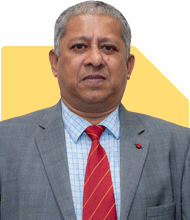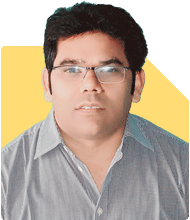Ramalingam Kalirajan |7453 Answers |Ask -Follow
Mutual Funds, Financial Planning Expert - Answered on Jun 14, 2024
He has an MBA in finance from the University of Madras and is a certified financial planner.
He is the director and chief financial planner at Holistic Investment, a Chennai-based firm that offers financial planning and wealth management advice.... more

Hi- I'm 37 years old with a monthly income of 2.25 lacs a month. I have ~20 lacs in PF, ~15 lacs in SIP, 60 lacs FD. I don't have any debt. My current monthly household exp including rent is 50k a month, monthly SIP of 21k a month. How can I accumulate a corpus of 3crores in the next 10 years?
Understanding Your Financial Standing
You are earning Rs 2.25 lacs per month and have no debt. This is a solid foundation. Your current savings include:
Rs 20 lacs in Provident Fund (PF)
Rs 15 lacs in Systematic Investment Plans (SIPs)
Rs 60 lacs in Fixed Deposits (FDs)
You have a monthly household expense of Rs 50k, including rent, and you contribute Rs 21k to SIPs monthly. These figures highlight your prudent saving habits. Now, let's explore how to enhance your strategy to reach your goal of Rs 3 crores.
Importance of Asset Allocation
Asset allocation is crucial for balancing risk and reward in your portfolio. Given your existing investments, it’s essential to diversify wisely across equity, debt, and other instruments to ensure optimal growth and risk management.
Equity Investments
Equities are vital for long-term growth. Considering the long-term horizon of 10 years, equities can provide higher returns. Actively managed mutual funds should be a significant part of your portfolio. These funds are managed by professional fund managers who aim to outperform the market.
Debt Investments
Debt investments provide stability and lower risk compared to equities. Your current FD investments offer safety but may not yield high returns. Including debt mutual funds can provide better returns while maintaining stability.
Balanced Funds
Balanced or hybrid funds offer a mix of equity and debt. They can provide the growth potential of equities with the stability of debt. This blend can be suitable for moderate risk-takers like yourself.
Reviewing Existing Investments
It’s vital to assess your existing investments to ensure they align with your goals. Here’s a breakdown:
Provident Fund (PF)
Your PF is a safe, long-term investment. Continue with this as it provides assured returns and tax benefits. However, relying solely on PF might not be sufficient for your ambitious goal.
Systematic Investment Plans (SIPs)
Your SIPs in mutual funds are a strong foundation. Increasing your SIP contributions will accelerate your corpus accumulation. Actively managed SIPs can potentially offer better returns than passive index funds.
Fixed Deposits (FDs)
FDs are low-risk but offer relatively lower returns. Consider redirecting a portion of your FD investments into higher-return investments like equities or balanced funds.
Enhancing Your SIP Contributions
Given your high monthly income and low expenses, increasing your SIP contributions is feasible. Analyzing your monthly budget can reveal potential areas to save and redirect towards SIPs.
Setting a SIP Target
To accumulate Rs 3 crores in 10 years, your SIP contributions should be strategically increased. An incremental approach can be beneficial. Start with a feasible increase and periodically review your progress.
Benefits of Active Fund Management
Actively managed funds, guided by expert fund managers, can potentially outperform the market. Unlike index funds, which merely track the market, actively managed funds aim to generate higher returns through strategic investments.
Emergency Fund and Insurance
Having an emergency fund is crucial. This fund should cover 6-12 months of expenses, ensuring financial security during unexpected events. Additionally, adequate health and life insurance are necessary to protect against unforeseen circumstances.
Building an Emergency Fund
Set aside a portion of your monthly income into a liquid or short-term debt fund. This ensures you can access funds easily without affecting your long-term investments.
Insurance Needs
Evaluate your existing insurance coverage. Ensure you have sufficient life insurance, preferably term insurance, and comprehensive health insurance. This safeguards your financial plan against emergencies.
Tax Efficiency
Investing in tax-efficient instruments can enhance your returns. Consider these options:
Equity-Linked Savings Scheme (ELSS)
ELSS funds offer tax benefits under Section 80C of the Income Tax Act. They also provide equity exposure, aligning with your long-term growth objectives.
Debt Funds and Taxation
Debt funds held for over three years qualify for long-term capital gains tax with indexation benefits. This can be more tax-efficient compared to FDs.
Regular Portfolio Review
Regularly reviewing and rebalancing your portfolio ensures alignment with your financial goals. Market conditions and personal circumstances change, requiring adjustments in your strategy.
Annual Portfolio Review
Conduct an annual review of your portfolio. Assess the performance of your investments and make necessary adjustments. Consult with a Certified Financial Planner for professional advice.
Rebalancing Strategy
Rebalancing involves realigning your portfolio to maintain your desired asset allocation. This might involve selling high-performing assets and reinvesting in underperforming ones to manage risk and returns.
Benefits of Professional Guidance
A Certified Financial Planner (CFP) can provide tailored advice and help navigate complex financial decisions. Professional guidance ensures your investment strategy is robust and aligned with your goals.
Avoiding Common Pitfalls
Disadvantages of Index Funds
Index funds merely replicate market indices and may not provide superior returns. Actively managed funds, on the other hand, strive for better performance through expert management.
Pitfalls of Direct Funds
Direct funds require investors to make all decisions without intermediary support. Investing through a Mutual Fund Distributor (MFD) with CFP credentials provides expert insights and can enhance your investment outcomes.
Financial Discipline and Patience
Achieving a significant corpus requires financial discipline and patience. Stick to your investment plan, avoid impulsive decisions, and stay focused on your long-term goals.
Final Insights
Accumulating Rs 3 crores in 10 years is achievable with strategic planning and disciplined investing. Here’s a summary of steps to follow:
Increase your SIP contributions, focusing on actively managed equity and balanced funds.
Diversify your investments to balance risk and reward.
Maintain an emergency fund and adequate insurance coverage.
Leverage tax-efficient investment options.
Regularly review and rebalance your portfolio.
Seek guidance from a Certified Financial Planner for professional advice.
By following these steps and maintaining financial discipline, you can successfully achieve your goal. Your proactive approach and prudent financial habits are commendable.
Best Regards,
K. Ramalingam, MBA, CFP,
Chief Financial Planner,
www.holisticinvestment.in
You may like to see similar questions and answers below
Ramalingam Kalirajan |7453 Answers |Ask -Follow
Mutual Funds, Financial Planning Expert - Answered on Jul 04, 2024
Ramalingam Kalirajan |7453 Answers |Ask -Follow
Mutual Funds, Financial Planning Expert - Answered on Jul 04, 2024
Ramalingam Kalirajan |7453 Answers |Ask -Follow
Mutual Funds, Financial Planning Expert - Answered on Jul 01, 2024
Ramalingam Kalirajan |7453 Answers |Ask -Follow
Mutual Funds, Financial Planning Expert - Answered on Jan 03, 2025
Prof Suvasish Mukhopadhyay |276 Answers |Ask -Follow
Career Counsellor - Answered on Jan 06, 2025
Dr Dipankar Dutta |736 Answers |Ask -Follow
Tech Careers and Skill Development Expert - Answered on Jan 06, 2025
Dr Dipankar Dutta |736 Answers |Ask -Follow
Tech Careers and Skill Development Expert - Answered on Jan 06, 2025
Milind Vadjikar |840 Answers |Ask -Follow
Insurance, Stocks, MF, PF Expert - Answered on Jan 06, 2025
Dr Dipankar Dutta |736 Answers |Ask -Follow
Tech Careers and Skill Development Expert - Answered on Jan 06, 2025
Milind Vadjikar |840 Answers |Ask -Follow
Insurance, Stocks, MF, PF Expert - Answered on Jan 06, 2025
Nayagam P P |4033 Answers |Ask -Follow
Career Counsellor - Answered on Jan 06, 2025
Onkar Singh |26 Answers |Ask -Follow
Career Management, Skills Development Expert - Answered on Jan 06, 2025
Kanchan Rai |474 Answers |Ask -Follow
Relationships Expert, Mind Coach - Answered on Jan 06, 2025
Kanchan Rai |474 Answers |Ask -Follow
Relationships Expert, Mind Coach - Answered on Jan 06, 2025


























